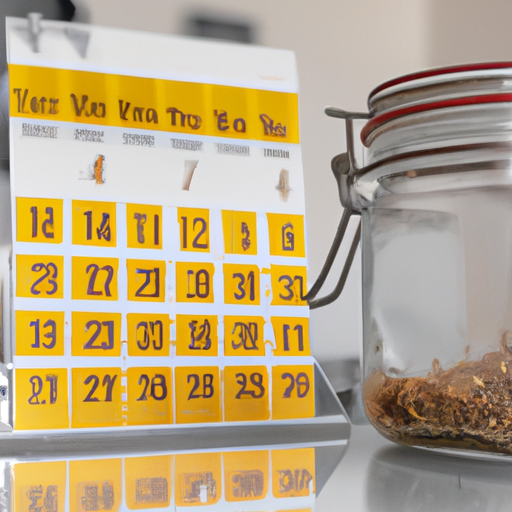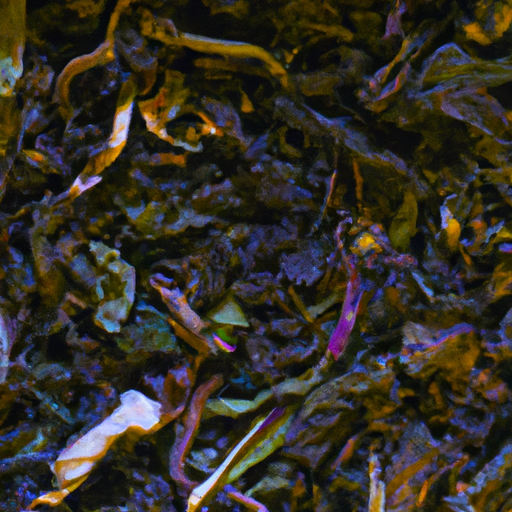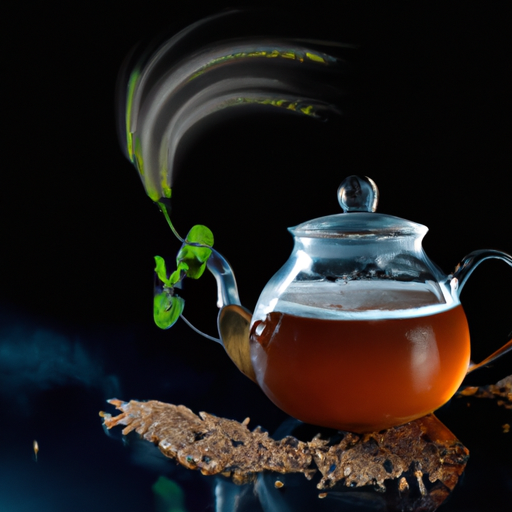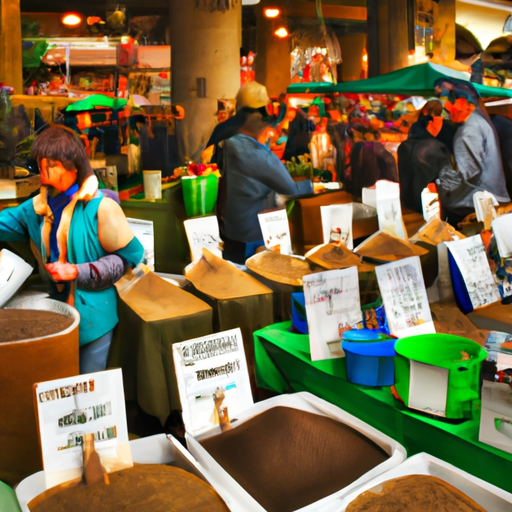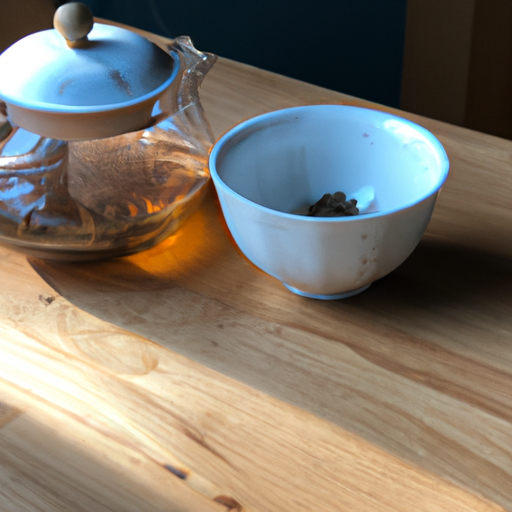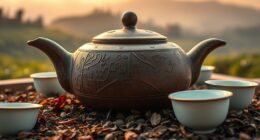Were you aware that in Japan, Korea, and China, barley tea ranks among the favorite beverages? Indeed, its popularity is such that it’s commonly offered in both restaurants and homes as a revitalizing and wholesome substitute for water.
But if you’re like me, you might be wondering how long you can store barley tea before it goes bad. In this article, I’ll share with you everything you need to know about the shelf life of barley tea, how to store it properly, and some tips for making it last longer.
As someone who enjoys a cup of barley tea every now and then, I’ve always been curious about how long I can keep it in my pantry. After all, I don’t want to waste any of this delicious and nutritious drink.
So, I did some research and found out that the shelf life of barley tea can vary depending on a few factors. In this article, I’ll break down those factors and give you some practical advice on how to store and preserve your barley tea for as long as possible.
Key Takeaways
- Barley tea has a shelf life of 6-12 months depending on storage, and should be checked for expiration dates and discarding if tea has turned brown or black or if packaging is torn.
- Barley tea should be stored in glass or ceramic containers with airtight lids in a cool, dry place away from direct sunlight and strong odors or spices. Avoid storing in the fridge or freezer.
- Preservatives can be added to extend shelf life, but natural alternatives like lemon juice or honey can also be used.
- Freezing can preserve barley tea for up to 6 months, but may alter flavor and texture and should be reheated by defrosting in the fridge and heating in a pot or microwave for 30 seconds to a minute at 158°F (70°C).
What is Barley Tea?
Do you know what barley tea is and how it can be a refreshing drink in the summer months? Barley tea, also known as roasted barley tea or mugicha, is a popular beverage in Asian countries like Japan, Korea, and China. It’s made from roasted barley grains and is caffeine-free, making it an excellent alternative to coffee and tea.
Barley tea has a nutty flavor and a slightly sweet taste, which makes it a refreshing drink in the summer months. It has many benefits for our health. Drinking barley tea regularly can help improve digestion, reduce inflammation, and boost immunity. It can also help lower cholesterol levels and blood pressure.
In traditional Chinese medicine, barley tea is used to treat digestive disorders, fever, and respiratory problems. In Japan, it is often consumed as a cold drink during the summer to cool the body and prevent heatstroke. Barley tea has been a part of different cultures for centuries. In Korea, it is served as a traditional drink during important occasions like weddings and funerals. In China, it is often consumed with meals to aid digestion. In Japan, it is a popular drink in the summer months and is often served in restaurants and cafes.
With its many health benefits and cultural significance, barley tea is a refreshing drink that is enjoyed by many people around the world. Now, let’s talk about the shelf life of barley tea and how long it can be stored.
Shelf Life of Barley Tea
To keep your barley tea fresh, make sure to check the expiration date on the packaging and consume it before that date to avoid any potential spoilage. Barley tea has a shelf life of about 6-12 months, depending on how it’s stored.
If you’ve had your barley tea for a while and are unsure if it’s still good, there are a few ways to tell if it’s gone bad. Firstly, check the packaging for any signs of damage or discoloration. If the packaging is torn or the tea has turned brown or black, it’s likely gone bad and should be discarded. Secondly, give the tea a sniff. If it has a sour or musty smell, it’s best to toss it out. Lastly, if you notice any mold, don’t take any chances and get rid of it immediately.
Drinking barley tea regularly has many benefits. It’s a great source of antioxidants, which can help protect your body from free radicals and reduce inflammation. It’s also caffeine-free, making it a good alternative for those trying to cut down on caffeine consumption. Additionally, barley tea has been shown to improve digestion, boost the immune system, and even help with weight loss.
In the next section, we’ll take a look at how to store barley tea properly to ensure it stays fresh for as long as possible.
How to Store Barley Tea
When it comes to storing barley tea, it’s important to use the best storage containers available.
I prefer to store my barley tea in glass or ceramic containers with airtight lids to prevent moisture and air from affecting the tea’s quality.
Additionally, the ideal storage conditions for barley tea include a cool and dry place away from direct sunlight.
Best Storage Containers
One great way to keep your barley tea fresh for an extended period is by storing it in airtight containers. There are various types of containers available in the market, each with its own set of pros and cons. Glass jars are a popular choice as they are transparent and allow you to see the contents inside. However, they are fragile and can break easily. Plastic containers are lightweight and durable, but they may not be as airtight as glass jars. Stainless steel containers are another option, but they can be expensive and may not be as widely available as glass or plastic containers.
To help you choose the best container for your barley tea, here is a table that compares the different types of containers based on their features:
| Container Type | Pros | Cons |
|---|---|---|
| Glass Jars | Transparent, easy to clean | Fragile, can break easily |
| Plastic Containers | Lightweight, durable | May not be as airtight as glass jars |
| Stainless Steel Containers | Durable, long-lasting | Expensive, not as widely available |
Now that you know the different types of barley tea containers and their pros and cons, it’s important to consider the ideal storage conditions for your tea.
Ideal Storage Conditions
For optimal freshness, your barley tea needs a storage environment as cool as a cucumber in the shade. This means that the ideal storage conditions for barley tea involve humidity control and temperature regulation. Here are four essential tips that can help you prolong the shelf life of your barley tea:
-
Keep your barley tea in an airtight container to prevent moisture and air from entering. This is essential to maintain the freshness of your tea leaves and prevent them from going stale.
-
Store the container in a cool, dry place away from direct sunlight. Exposure to heat and light can cause the tea leaves to lose their flavor and aroma quickly.
-
Avoid storing your barley tea near strong odors or spices that can contaminate the flavor of the tea leaves.
-
Don’t store your tea in the fridge or freezer. Although these storage areas can offer a cool environment, they also have high humidity levels that can damage the tea leaves.
By following these tips, you can ensure that your barley tea stays fresh and flavorful for longer.
Tips for Prolonging the Shelf Life of Barley Tea
To keep your barley tea fresh and delicious for as long as possible, you should make sure to store it in an airtight container in a cool, dry place. This will prevent moisture and air from getting to the tea, which can cause it to spoil more quickly. Additionally, you should avoid storing your barley tea in areas that are exposed to direct sunlight or heat, as these can also have a negative impact on its shelf life.
If you find that you have leftover barley tea, there are a few ways that you can reuse it. For example, you can use it as a natural toner for your skin. Simply apply the leftover tea to your face with a cotton ball and let it sit for a few minutes before rinsing it off. The antioxidants in barley tea can help to protect your skin from free radicals and other environmental stressors, which can lead to premature aging and other skin issues.
There are a few other tips that can help you to prolong the shelf life of your barley tea. For example, you can try adding a bit of honey or lemon juice to the tea, which can help to preserve it and add some extra flavor. You can also try storing your tea in the freezer, which can help to extend its shelf life even further.
With these tips in mind, you can enjoy fresh, delicious barley tea for weeks or even months to come. To make barley tea last even longer, there are a few additional steps that you can take.
How to Make Barley Tea Last Longer
I’ve found a few ways to make my barley tea last longer. One effective method is using tea bags instead of loose barley grains. This helps prevent spoilage and makes it easier to store.
Another option is adding preservatives like citric acid or Vitamin C, which can also help prolong its shelf life.
Finally, freezing barley tea is a great way to keep it fresh for longer periods of time. Just make sure to store it in an airtight container to prevent freezer burn.
Using Tea Bags
If you’re a fan of using tea bags to make your barley tea, you’ll be pleased to know that it can be stored in the refrigerator for up to a week without losing its flavor. Using tea bags can provide several benefits, such as convenience and consistency in taste. It’s also a great option for those who are new to brewing barley tea and are still experimenting with different brewing methods.
To make sure your barley tea stays fresh for up to a week, it’s important to store it properly. After brewing, remove the tea bags and let the tea cool to room temperature before transferring it into an airtight container. Keep it in the refrigerator and consume within a week to ensure its freshness.
If you’re looking to store your barley tea for a longer period, you may consider adding preservatives to extend its shelf life.
Adding Preservatives
Using tea bags to make barley tea is a convenient way to enjoy this refreshing beverage. However, if you want to store barley tea for an extended period, adding preservatives might be necessary. While this method can prolong the shelf life of your barley tea, there are also some drawbacks to consider.
If you want to add preservatives to your barley tea, there are several options available, including citric acid, ascorbic acid, and potassium sorbate. These preservatives can prevent the growth of bacteria and fungi, which can cause spoilage and affect the taste and quality of your tea. However, using preservatives can have some negative effects on your health and the environment. For instance, some preservatives can cause allergic reactions or digestive problems, while others can accumulate in water and soil and have harmful effects on aquatic life and wildlife.
Fortunately, using natural alternatives to preserve your barley tea is also possible. For example, you can use lemon juice or honey, which have antimicrobial properties and can enhance the flavor of your tea. Moreover, storing your barley tea in airtight containers, in a cool and dry place, can also prevent spoilage and maintain its freshness.
In the next section, we’ll discuss how freezing barley tea can also be an effective way to store it for a longer time.
Freezing Barley Tea
To extend the shelf life of your refreshing barley tea, consider freezing it. Freezing is a great way to preserve the flavor and quality of the tea for up to six months. Freezing also helps to prevent spoilage and bacterial growth, which can occur over time when the tea is stored at room temperature.
One of the benefits of freezing barley tea is that it helps to maintain the flavor of the tea. When the tea is frozen, the tea leaves and water molecules are locked in place, which helps to prevent the tea from losing its flavor. However, it’s important to note that freezing can cause some changes in the taste and texture of the tea. For instance, the tea may become slightly more bitter or have a slightly different texture.
Despite these changes, freezing is still a great way to preserve the tea and enjoy it at a later time. To reheat barley tea after it has been frozen, there are a few steps to follow. First, remove the tea from the freezer and allow it to defrost in the refrigerator for a few hours. Once the tea has defrosted, heat it up in a pot on the stove or in the microwave. Be sure to use a low heat setting to avoid boiling the tea as this can cause the flavor to become overcooked.
With these simple steps, you can enjoy your frozen barley tea without losing any of its refreshing flavor.
How to Reheat Barley Tea
Reheating barley tea is a simple way to enjoy its refreshing taste again. There are several reheating methods you can use for barley tea, but the most common one is to use a microwave. To do this, simply pour the desired amount of tea into a microwave-safe container and heat it for 30 seconds to a minute. Make sure to stir the tea before drinking to ensure an even temperature.
Temperature control is important when reheating barley tea. You don’t want to overheat the tea, as this can cause it to lose its flavor and nutrients. Keep in mind that barley tea should never be boiled, as this can result in a bitter taste. Instead, aim for a temperature of around 158°F (70°C) for the best results.
When reheating barley tea, it’s important to remember that the taste may not be exactly the same as when it was first brewed. However, with the right temperature control and reheating method, you can still enjoy a delicious and refreshing cup of tea.
Now that you know how to reheat your barley tea, let’s move on to the next section about how to brew it from scratch.
How to Brew Barley Tea
Brewing a fresh batch of this nutty and caffeine-free beverage is a simple process that requires only a few ingredients. To start, you’ll need barley tea leaves, water, and a teapot.
The water temperature is crucial when brewing barley tea. It’s recommended that you use boiling water, but let it cool down for a minute before pouring it onto the tea leaves. This will prevent the tea from becoming bitter.
Next, add the desired amount of barley tea leaves into the teapot and pour the hot water over them. Steeping time is also important when brewing barley tea. A general rule of thumb is to steep the tea for around 3-5 minutes. However, you can adjust the steeping time based on your preference. If you enjoy a stronger flavor, you can steep the tea for a longer period of time.
Brewing barley tea is a simple process that can be customized to your liking. Once you’ve brewed the tea, you can enjoy it hot or cold. Now that you know how to brew barley tea, let’s dive into the health benefits of this delicious beverage.
Health Benefits of Barley Tea
Barley tea isn’t just a tasty drink, it also provides many health benefits. One of the most significant advantages of barley tea is that it has very little caffeine. Unlike green tea or black tea, barley tea lacks caffeine that can cause jitters or sleeplessness. This makes barley tea an ideal option for people who want to enjoy a warm cup of tea without the negative effects of caffeine.
Another health benefit of barley tea is its impact on digestion. Barley tea has compounds that stimulate digestion and relieve common digestive problems such as constipation, bloating, and indigestion. Besides, barley tea has anti-inflammatory properties that can soothe the digestive system and reduce inflammation in the gut.
Barley tea is a healthy and delicious drink that can offer numerous health benefits. From its low caffeine content to its positive effect on digestion, barley tea is an excellent choice for anyone looking for a warm and comforting beverage. In the next section, we’ll discuss the popular varieties of barley tea and how to prepare them.
Popular Varieties of Barley Tea
After learning about the health benefits of barley tea, let’s now explore the different types of barley tea and the brewing techniques that can be used to make this refreshing beverage.
Barley tea is a popular drink in many countries, including Japan, Korea, and China. There are several varieties of barley tea, each with its unique flavor and aroma.
One of the most common types of barley tea is roasted barley tea, also known as mugicha in Japan. This tea is made by roasting barley grains until they turn brown and then steeping them in hot water. Roasted barley tea has a nutty, toasty flavor and is often served cold in the summer months.
Another popular variety is barley tea with corn, which is made by adding corn kernels to the barley during the roasting process. This tea has a slightly sweet taste and is often served hot.
When it comes to brewing barley tea, there are several techniques that can be used. One method is to steep the tea in hot water for several minutes, similar to how you would brew a cup of tea. Another technique is to boil the barley grains in water for several minutes, then strain the liquid and serve it hot or cold.
Some people also like to add other ingredients to their barley tea, such as honey, lemon, or ginger, to enhance the flavor. Overall, barley tea is a versatile and delicious beverage that can be enjoyed in many different ways.
Frequently Asked Questions
Does barley tea have any caffeine or other stimulants?
As someone who enjoys a cup of barley tea every now and then, I was curious about its caffeine content and health benefits. Interestingly, barley tea is completely caffeine-free, making it a great option for those looking to cut down on their caffeine intake.
But just because it’s caffeine-free doesn’t mean it’s lacking in health benefits. Barley tea is known for its high antioxidant content, which can help protect against free radicals and promote overall wellness. Additionally, it has been shown to have anti-inflammatory properties and may even help improve digestion.
Compared to other herbal teas, barley tea stands out for its unique flavor profile and potential health benefits.
Can barley tea be consumed hot or cold?
Barley tea can be consumed both hot and cold, and each method has its own pros and cons. When consumed hot, barley tea can help to warm the body and aid in digestion. It can also be a comforting drink during colder months.
However, when consumed cold, barley tea can be a refreshing and hydrating beverage during warmer months. Additionally, cold barley tea can be a good option for those who are sensitive to caffeine, as the cooling process can reduce the caffeine content.
Overall, the choice between hot or cold barley tea depends on personal preference and the situation.
Is it safe to drink expired barley tea?
When it comes to drinking expired barley tea, there are several shelf life considerations and health risks to keep in mind.
First and foremost, consuming expired barley tea may lead to bacterial contamination, which can cause foodborne illnesses such as diarrhea, vomiting, and fever.
Additionally, the taste and quality of the tea may deteriorate over time, making it less enjoyable to drink.
To minimize these risks, it’s important to always check the expiration date on the packaging and store the tea in a cool, dry place away from direct sunlight.
If you’re unsure whether your barley tea is still safe to drink, it’s best to err on the side of caution and dispose of it.
Can barley tea be brewed with other herbs or spices?
As they say, variety’s the spice of life, and that definitely applies when it comes to brewing barley tea.
There are numerous brewing variations that allow you to infuse other herbs or spices with the barley, creating unique flavors and additional health benefits.
For example, adding mint leaves can help soothe an upset stomach, while ginger can provide anti-inflammatory properties. Other popular additions include cinnamon, lemon, and honey.
These variations not only enhance the taste of the tea, but they also offer additional nutritional benefits.
So, if you want to mix things up and add some excitement to your daily cup of barley tea, feel free to experiment and discover your own perfect blend.
Are there any potential side effects of drinking barley tea?
After researching, I’ve found that there are potential health benefits to drinking barley tea. It contains antioxidants and has been shown to help lower cholesterol levels and blood pressure.
However, it’s important to note that excessive intake of barley tea can lead to increased urination and dehydration. The recommended daily intake of barley tea is 2-3 cups per day.
It’s important to consult with a healthcare professional before consuming large amounts of barley tea.
Conclusion
In conclusion, I’m excited to continue enjoying this delicious and healthy beverage after learning about the shelf life of barley tea and how to store it properly. As a busy person, I appreciate the convenience of being able to make a large batch and store it for later consumption.
By following the tips shared in this article, I can ensure that my barley tea will stay fresh and flavorful for as long as possible.
As someone who is health-conscious, I’m pleased to learn about the many health benefits of barley tea. From its ability to aid in digestion and reduce inflammation to its high antioxidant content, barley tea is a great addition to any diet.
With so many varieties to choose from, I look forward to exploring the different flavors and finding my new favorite. Overall, I highly recommend giving barley tea a try and incorporating it into your daily routine.

